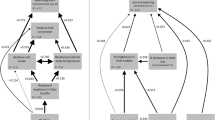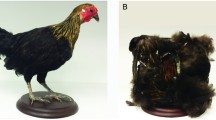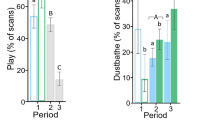Abstract
Widespread recognition of the contribution of individual differences in behavioral phenotype to evolutionary processes raises questions as to their developmental origin: when and in what contexts such differences emerge and what aspects of the developmental environment contribute to these? We studied individual differences among littermates of the domestic cat Felis silvestris catus when competing for meat at weaning, a challenging period in mammalian development. During postnatal weeks six, seven, and eight, we tested 67 weanling kittens (40 males, 27 females) from 16 litters of mixed breed cats maintained as part of a free-ranging breeding colony. Twice a week, we tested the kittens’ behavior after they were food deprived and presented together with their siblings for 2 min with a highly palatable food, a piece of raw beef. We found stable individual differences among littermates across 3 weeks of testing in latency to reach the meat, time spent eating from it, time spent monopolizing it, and number of aggressive behaviors directed toward littermates. There was no effect of sex on any of the behavioral measures. However, kittens with lower body mass at birth (and then also lower body mass at the age of testing) relative to their littermates competed more vigorously and successfully for the meat than their heavier siblings. This suggests the importance of motivational factors arising during early development in sha** individual differences in behavior such as among littermates in the present study, when competing for a biologically relevant resource.
Significance statement
In polytocous mammals, body mass at birth is a good predictor of growth and survival, with heavier young relative to their littermates usually obtaining a greater share of resources such as the mother’s milk. It is therefore often assumed that this advantage will translate into differences in behavior in other contexts, such that heavier littermates will gain more resources at later life stages by showing a more aggressive, “dominant” behavioral style. The findings of the present study challenge this view by demonstrating that in the domestic cat, lighter littermates were more competitive in obtaining meat at weaning. We suggest that differences in the motivational state of individuals should also be considered when accounting for the early development of individual differences in behavior, including among littermates, and may contribute to what might be broadly considered an individual’s personality or behavioral style.

Similar content being viewed by others
Data availability
The datasets generated during and/or analyzed during the current study are available in the Figshare Data Repository, https://doi.org/10.6084/m9.figshare.14802906.
Code availability
Not applicable.
References
Adamec RE, Stark-Adamec C, Livingston KE (1980a) The development of predatory aggression and defense in the domestic cat (Felis catus): I. Effects of early experience on adult patterns of aggression and defense. Behav Neural Biol 30:389–409. https://doi.org/10.1016/S0163-1047(80)91256-X
Adamec RE, Stark-Adamec C, Livingston KE (1980b) The development of predatory aggression and defense in the domestic cat (Felis catus): II. Development of aggression and defense in the first 164 days of life. Behav Neural Biol 30:410–434. https://doi.org/10.1016/S0163-1047(80)91265-0
Adamec RE, Stark-Adamec C, Livingston KE (1980c) The development of predatory aggression and defense in the domestic cat (Felis catus): III. Effects on development of hunger between 180 and 365 days of age. Behav Neural Biol 30:435–447. https://doi.org/10.1016/S0163-1047(80)91274-1
Andersen IL, Nævdal E, Bøe KE (2011) Maternal investment, sibling competition, and offspring survival with increasing litter size and parity in pigs (Sus scrofa). Behav Ecol Sociobiol 65:1159–1167. https://doi.org/10.1007/s00265-010-1128-4
Antonevich AL, Naidenko SV, Bergara J, Vasques E, Vasques A, Lopez J, Pardo A, Rivas A, Chaparro JM, Martinez F (2009) A comparative note on early sibling aggression in two related species: the Iberian and the Eurasian lynx. In: Vargas A, Breitenmoser C, Breitenmoser U (eds) Iberian lynx ex situ conservation: an interdisciplinary approach. Fundación Biodiversidad, Madrid, Spain, pp 156–163
Bateson P (2014) Behavioural development in the cat. In: Turner DC, Bateson P (eds) The domestic cat: the biology of its behaviour, 3rd edn. Cambridge University Press, Cambridge, UK, pp 11–26
Bateson P, Barker D, Clutton-Brock T, Deb D, D’Udine B, Foley RA, Gluckman P, Godfrey K, Kirkwood T, Lahr MM (2004) Developmental plasticity and human health. Nature 430:419–421. https://doi.org/10.1038/nature02725
Bautista A, Castelán F, Pérez-Roldán H, Martínez-Gómez M, Hudson R (2013) Competition in newborn rabbits for thermally advantageous positions in the litter huddle is associated with individual differences in brown fat metabolism. Physiol Behav 118:189–194. https://doi.org/10.1016/j.physbeh.2013.05.035
Bautista A, Drummond H, Martínez-Gómez M, Hudson R (2003) Thermal benefit of sibling presence in the newborn rabbit. Dev Psychobiol 43:208–215. https://doi.org/10.1002/dev.10134
Bautista A, García-Torres E, Martínez-Gómez M, Hudson R (2008) Do newborn domestic rabbits Oryctolagus cuniculus compete for thermally advantageous positions in the litter huddle? Behav Ecol Sociobiol 62:331–339. https://doi.org/10.1007/s00265-007-0420-4
Bautista A, Mendoza-Degante M, Coureaud G, Martínez-Gómez M, Hudson R (2005) Scramble competition in newborn domestic rabbits for an unusually restricted milk supply. Anim Behav 70:1011–1021. https://doi.org/10.1016/j.anbehav.2005.01.015
Bautista A, Rödel HG, Monclús R, Juárez-Romero M, Cruz-Sánchez E, Martínez-Gómez M, Hudson R (2015a) Intrauterine position as a predictor of postnatal growth and survival in the rabbit. Physiol Behav 138:101–106. https://doi.org/10.1016/j.physbeh.2014.10.028
Bautista A, Zepeda JA, Reyes-Meza V, Féron C, Rödel HG, Hudson R (2017) Body mass modulates huddling dynamics and body temperature profiles in rabbit pups. Physiol Behav 179:184–190. https://doi.org/10.1016/j.physbeh.2017.06.005
Bautista A, Zepeda JA, Reyes-Meza V, Martínez-Gómez M, Rödel HG, Hudson R (2015b) Contribution of within-litter interactions to individual differences in early postnatal growth in the domestic rabbit. Anim Behav 108:145–153. https://doi.org/10.1016/j.anbehav.2015.07.028
Baxter E, Jarvis S, D’eath R, Ross D, Robson S, Farish M, Nevison I, Lawrence A, Edwards S, (2008) Investigating the behavioural and physiological indicators of neonatal survival in pigs. Theriogenology 69:773–783. https://doi.org/10.1016/j.theriogenology.2007.12.007
Benhaiem S, Hofer H, Kramer-Schadt S, Brunner E, East ML (2012) Sibling rivalry: training effects, emergence of dominance and incomplete control. Proc R Soc B Lond 279:3727–3735. https://doi.org/10.1098/rspb.2012.0925
Biró Z, Lanszki J, Szemethy L, Heltai M, Randi E (2005) Feeding habits of feral domestic cats (Felis catus), wild cats (Felis silvestris) and their hybrids: trophic niche overlap among cat groups in Hungary. J Zool 266:187–196. https://doi.org/10.1017/S0952836905006771
Campos PHRF, Silva BAN, Donzele JL, Oliveira RFM, Knol EF (2012) Effects of sow nutrition during gestation on within-litter birth weight variation: a review. Animal 6:797–806. https://doi.org/10.1017/S1751731111002242
Drummond H (2006) Dominance in vertebrate broods and litters. Q Rev Biol 81:3–32. https://doi.org/10.1086/503922
Drummond H, Vázquez E, Sánchez-Colón S, Martínez-Gómez M, Hudson R (2000) Competition for milk in the domestic rabbit: survivors benefit from littermate deaths. Ethology 106:511–526. https://doi.org/10.1046/j.1439-0310.2000.00554.x
Dunn J, Plomin R (1990) Separate lives: why siblings are so different. Basic Books, New York, USA
Dunn J, Plomin R (1991) Why are siblings so different? The significance of differences in sibling experiences within the family. Fam Process 30:271–283. https://doi.org/10.1111/j.1545-5300.1991.00271.x
Fey K, Trillmich F (2008) Sibling competition in guinea pigs (Cavia aperea f. porcellus): scrambling for mother’s teats is stressful. Behav Ecol Sociobiol 62:321–329. https://doi.org/10.1007/s00265-007-0419-x
Foxcroft G, Dixon W, Novak S, Putman C, Town S, Vinsky M (2006) The biological basis for prenatal programming of postnatal performance in pigs. J Anim Sci 84:E105–E112. https://doi.org/10.2527/2006.8413_supplE105x
Frafjord K (1993) Agonistic behaviour and dominance relations of captive arctic foxes (Alopex lagopus) in Svalbard. Behav Process 29:239–251. https://doi.org/10.1016/0376-6357(93)90127-D
Fraser D (1989) Behavioural perspectives on piglet survival. J Reprod Fertil Suppl 40:355–370
Gilbert C, McCafferty D, Le Maho Y, Martrette JM, Giroud S, Blanc S, Ancel A (2010) One for all and all for one: the energetic benefits of huddling in endotherms. Biol Rev 85:545–569. https://doi.org/10.1111/j.1469-185X.2009.00115.x
Golla W, Hofer H, East ML (1999) Within-litter sibling aggression in spotted hyaenas: effect of maternal nursing, sex and age. Anim Behav 58:715–726. https://doi.org/10.1006/anbe.1999.1189
González D, Szenczi P, Bánszegi O, Hudson R (2018) Testing aggressive behaviour in a feeding context: importance of ethologically relevant stimuli. Behav Process 150:1–7. https://doi.org/10.1016/j.beproc.2018.02.011
Groó Z, Szenczi P, Bánszegi O, Nagy Z, Altbäcker V (2018) The influence of familiarity and temperature on the huddling behavior of two mouse species with contrasting social systems. Behav Process 151:67–72. https://doi.org/10.1016/j.beproc.2018.03.007
Guenther A, Trillmich F (2015) Within-litter differences in personality and physiology relate to size differences among siblings in cavies. Physiol Behav 145:22–28. https://doi.org/10.1016/j.physbeh.2015.03.026
Hartsock TG, Graves HB (1976) Piglet fighting behaviour, nursing order and growth. J Anim Sci 43:209. https://doi.org/10.2527/jas1976.431209x(abstract)
Henry JD (1985) The little foxes. Nat Hist 94:46–57
Hodge SJ, Flower TP, Clutton-Brock TH (2007) Offspring competition and helper associations in cooperative meerkats. Anim Behav 74:957–964. https://doi.org/10.1016/j.anbehav.2006.10.029
Hofer H, East ML (1993) The commuting system of Serengeti spotted hyaenas: how a predator copes with migratory prey. III. Attendance and maternal care. Anim Behav 46:575–589. https://doi.org/10.1006/anbe.1993.1224
Hofer H, East ML (1997) Skewed offspring sex ratios and sex composition of twin litters in Serengeti spotted hyaenas (Crocuta crocuta) are a consequence of siblicide. Appl Anim Behav Sci 51:307–316. https://doi.org/10.1016/S0168-1591(96)01113-6
Hofer H, East ML (2008) Siblicide in Serengeti spotted hyenas: a long-term study of maternal input and cub survival. Behav Ecol Sociobiol 62:341–351. https://doi.org/10.1007/s00265-007-0421-3
Hudson R, Bautista A, Reyes-Meza V, Montor JM, Rödel HG (2011) The effect of siblings on early development: a potential contributor to personality differences in mammals. Dev Psychobiol 53:564–574. https://doi.org/10.1002/dev.20535
Hudson R, Distel H (2013) Fighting by kittens and piglets during suckling: what does it mean? Ethology 119:353–359. https://doi.org/10.1111/eth.12082
Hudson R, Raihani G, González D, Bautista A, Distel H (2009) Nipple preference and contests in suckling kittens of the domestic cat are unrelated to presumed nipple quality. Dev Psychobiol 51:322–332. https://doi.org/10.1002/dev.20371
Hudson R, Rangassamy M, Saldaña A, Bánszegi O, Rödel HG (2015) Stable individual differences in separation calls during early development in cats and mice. Front Zool 12:S12. https://doi.org/10.1186/1742-9994-12-S1-S12
Hudson R, Trillmich F (2008) Sibling competition and cooperation in mammals: challenges, developments and prospects. Behav Ecol Sociobiol 62:299–307. https://doi.org/10.1007/s00265-007-0417-z
Huntingford FA, Turner A (1987) Animal conflict. Chapman & Hall, London, UK
Izawa M, Ono Y (1986) Mother-offspring relationship in the feral cat population. J Mammal Soc Jpn 11:27–34. https://doi.org/10.11238/jmammsocjapan1952.11.27
Kaufmann JH (1983) On the definitions and functions of dominance and territoriality. Biol Rev 58:1–20. https://doi.org/10.1111/j.1469-185X.1983.tb00379.x
Lessells CM, Boag PT (1987) Unrepeatable repeatabilities: a common mistake. Auk 104:116–121. https://doi.org/10.2307/4087240
Luo D, Ganesh S, Koolaard J (2020) Predictmeans: calculate predicted means for linear models. Version: 1.0.4, https://CRAN.R-project.org/package=predictmeans
Martin P (1986) An experimental study of weaning in the domestic cat. Behaviour 99:221–249. https://doi.org/10.1163/156853986X00568
Martínez-Byer S, Urrutia A, Szenczi P, Hudson R, Bánszegi O (2020) Evidence for individual differences in behaviour and for behavioural syndromes in adult shelter cats. Animals 10:962. https://doi.org/10.3390/ani10060962
Martínez-Gómez M, Juárez M, Distel H, Hudson R (2004) Overlap** litters and reproductive performance in the domestic rabbit. Physiol Behav 82:629. https://doi.org/10.1016/j.physbeh.2004.05.011
Mech LD (1999) Alpha status, dominance, and division of labor in wolf packs. Can J Zool 77:1196–1203. https://doi.org/10.1139/z99-099
Mech LD, Boitani L (2006) Wolves: behavior, ecology, and conservation. University of Chicago Press, Chicago, USA
Mendl M (1988) The effects of litter size variation on mother-offspring relationships and behavioural and physical development in several mammalian species (principally rodents). J Zool 215:15–34. https://doi.org/10.1111/j.1469-7998.1988.tb04882.x
Milligan BN, Fraser D, Kramer DL (2002) Within-litter birth weight variation in the domestic pig and its relation to pre-weaning survival, weight gain, and variation in weaning weights. Livest Prod Sci 76:181–191. https://doi.org/10.1016/S0301-6226(02)00012-X
Mock DW, Parker GA (1997) The evolution of sibling rivalry. Oxford University Press, Oxford, UK
Nicolás L, Martínez-Gómez M, Hudson R, Bautista A (2011) Littermate presence enhances motor development, weight gain and competitive ability in newborn and juvenile domestic rabbits. Dev Psychobiol 53:37–46. https://doi.org/10.1002/dev.20485
Péter A (2015) Solomon Coder: a simple solution for behavior coding. Version: beta 17.03.22. http://www.solomoncoder.com/
R Core Team (2019) R: A language and environment for statistical computing. Version: 3.6.1. R Foundation for Statistical Computing, Vienna, Austria, http://www.R-project.org
Réale D, Dingemanse NJ, Kazem AJN, Wright J (2010) Evolutionary and ecological approaches to the study of personality. Phil Trans R Soc B 365:3937–3946. https://doi.org/10.1098/rstb.2010.0222
Reyes-Meza V, Hudson R, Martínez-Gómez M, Nicolás L, Rödel HG, Bautista A (2011) Possible contribution of position in the litter huddle to long-term differences in behavioral style in the domestic rabbit. Physiol Behav 104:778–785. https://doi.org/10.1016/j.physbeh.2011.07.019
Roche DG, Careau V, Binning SA (2016) Demystifying animal ‘personality’(or not): why individual variation matters to experimental biologists. J Exp Biol 219:3832–3843. https://doi.org/10.1242/jeb.146712
Rödel HG, Bautista A, García-Torres E, Martínez-Gómez M, Hudson R (2008a) Why do heavy littermates grow better than lighter ones? A study in wild and domestic European rabbits. Physiol Behav 95:441–448. https://doi.org/10.1016/j.physbeh.2008.07.011
Rödel HG, Hudson R, Rammler L, Sänger N, Schwarz L, Machnik P (2012) Lactation does not alter the long-term stability of individual differences in behavior of laboratory mice on the elevated plus maze. J Ethol 30:263–270. https://doi.org/10.1007/s10164-011-0320-y
Rödel HG, Hudson R, von Holst D (2008b) Optimal litter size for individual growth of European rabbit pups depends on their thermal environment. Oecologia 155:677–689. https://doi.org/10.1007/s00442-008-0958-5
Rödel HG, Monclús R (2011) Long-term consequences of early development on personality traits: a study in European rabbits. Behav Ecol 22:1123–1130. https://doi.org/10.1093/beheco/arr100
Rödel HG, Oppelt C, Starkloff A, Prager N, Long E, Rüdiger A-T, Seltmann MW, Monclús R, Hudson R, Poteaux C (2020) Within-litter covariance of allele-specific MHC heterozygosity, coccidian endoparasite load and growth is modulated by sibling differences in starting mass. Oecologia 194:345–357. https://doi.org/10.1007/s00442-020-04764-z
Rödel HG, von Holst D (2009) Features of the early juvenile development predict competitive performance in male European rabbits. Physiol Behav 97:495–502. https://doi.org/10.1016/j.physbeh.2009.04.005
Rödel HG, Zapka M, Talke S, Kornatz T, Bruchner B, Hedler C (2015) Survival costs of fast exploration during juvenile life in a small mammal. Behav Ecol Sociobiol 69:205–217. https://doi.org/10.1007/s00265-014-1833-5
Ryan V, Wehmer F (1975) Effect of postnatal litter size on adult aggression in the laboratory mouse. Dev Psychobiol 8:363–370. https://doi.org/10.1002/dev.420080410
Sachser N, Hennessy MB, Kaiser S (2011) Adaptive modulation of behavioural profiles by social stress during early phases of life and adolescence. Neurosci Biobehav Rev 35:1518–1533. https://doi.org/10.1016/j.neubiorev.2010.09.002
Schmidt PM, Lopez RR, Collier BA (2007) Survival, fecundity, and movements of free-roaming cats. J Wildlife Manage 71:915–919. https://doi.org/10.2193/2006-066
Spotte S (2014) Free-ranging cats: behavior, ecology, management, 1st edn. John Wiley & Sons, Chichester, UK
Stockley P, Parker GA (2002) Life history consequences of mammal sibling rivalry. P Natl Acad Sci USA 99:12932–12937. https://doi.org/10.1073/pnas.192125999
Stoffel MA, Nakagawa S, Schielzeth H (2017) rptR: repeatability estimation and variance decomposition by generalized linear mixed-effects models. Methods Ecol Evol 8:1639–1644. https://doi.org/10.1111/2041-210x.12797
Strand O, Landa A, Linnell JDC, Zimmermann B, Skogland T (2000) Social organization and parental behavior in the arctic fox. J Mammal 81:223–233. https://doi.org/10.1644/1545-1542(2000)081%3c0223:SOAPBI%3e2.0.CO;2
Sulloway FJ (2010) Why siblings are like Darwin’s finches: birth order, sibling competition, and adaptive divergence within the family. In: Buss DM, Hawley PH (eds) The evolution of personality and individual differences. Oxford University Press, New York, USA, pp 86–119
Szenczi P, Bánszegi O, Dúcs A, Gedeon CI, Markó G, Németh I, Altbäcker V (2011) Morphology and function of communal mounds of overwintering mound-building mice (Mus spicilegus). J Mammal 92:852–860. https://doi.org/10.1644/10-MAMM-A-258.1
Trillmich F, Günther A, Müller C, Reinhold K, Sachser N (eds) (2015) New perspectives in behavioural development: adaptive sha** of behaviour over a lifetime? Front Zool 12:S1https://doi.org/10.1186/1742-9994-12-S1-S1
Trillmich F, Hudson R (eds) (2011) Special issue: The emergence of personality in animals: the need for a developmental approach. Dev Psychobiol 53:505-655. https://doi.org/10.1002/dev.20573
Urrutia A, Martínez-Byer S, Szenczi P, Hudson R, Bánszegi O (2019) Stable individual differences in vocalisation and motor activity during acute stress in the domestic cat. Behav Process 165:58–65. https://doi.org/10.1016/j.beproc.2019.05.022
Vullioud C, Davidian E, Wachter B, Rousset F, Courtiol A, Höner OP (2019) Social support drives female dominance in the spotted hyaena. Nat Ecol Evol 3:71–76. https://doi.org/10.1038/s41559-018-0718-9
Wachter B, Höner OP, East ML, Golla W, Hofer H (2002) Low aggression levels and unbiased sex ratios in a prey-rich environment: no evidence of siblicide in Ngorongoro spotted hyenas (Crocuta crocuta). Behav Ecol Sociobiol 52:348–356. https://doi.org/10.1007/s00265-002-0522-y
Zepeda JA, Rödel HG, Monclús R, Hudson R, Bautista A (2019) Sibling differences in litter huddle position contribute to overall variation in weaning mass in a small mammal. Behav Ecol Sociobiol 73:165. https://doi.org/10.1007/s00265-019-2777-6
Acknowledgements
The authors thank Liliana Ivonne García Mondragón and Yasemin Gultekin for help with video analysis, Carolina Rojas for administrative organization, Royal Canin® for generous support of our research, and our two anonymous reviewers who helped a lot improving the manuscript.
Funding
Financial support was provided by research grants from the Dirección General de Asuntos del Personal Académico (DGAPA), Universidad Nacional Autónoma de México (UNAM) [DGAPA-; IN212416; IN23120] and by an ongoing program of collaboration between France and Mexico, ECOS-NORD-AUNIES, Nos. 2999016 and M19A01 for Mexico and France, respectively. The research was supported by the Instituto de Investigaciones Biomédicas, UNAM, by a postdoctoral fellowship to OB, and by the Consejo Nacional de Ciencia y Tecnologia (CONACyT) by a postdoctoral fellowship to PS (Cátedra 691) and a doctoral fellowship to DG (No. 292461).
Author information
Authors and Affiliations
Contributions
Conceptualization: P.S., R.H., H.G.R., and O.B.; methodology: P.S., O.B., R.H., and S.M.-B.; data collection and video analysis: O.B., P.S., D.G., and S.M.-B.; statistical analysis: P.S. and H.G.R.; visualization: P.S., D.G.; writing—original draft preparation: O.B., P.S., D.G., S.M.-B.; writing—review and editing: O.B., R.H., H.G.R.; supervision: O.B. and P.S.; project administration: D.G. and S.M.-B.; funding acquisition: R.H.
Corresponding authors
Ethics declarations
Ethics approval
Throughout the study, animals were kept and treated according to the ASAB/ABS (2016) guidelines for the care and use of animals in research, with the guidelines for the treatment of animals in behavioral research of the Instituto de Investigaciones Biomédicas, Universidad Nacional Autónoma de México, and according to the National Guide for the Production, Care and Use of Laboratory Animals, Mexico (Norma Oficial Mexicana NOM-062–200-1999). The present study did not require ethical approval from the institute’s ethics committee.
Consent to participate
Not applicable.
Consent for publication
Not applicable.
Competing interests
The authors declare no competing interests.
Additional information
Communicated by A. I Schulte-Hostedde.
Publisher's note
Springer Nature remains neutral with regard to jurisdictional claims in published maps and institutional affiliations.
Rights and permissions
About this article
Cite this article
Szenczi, P., González, D., Martínez-Byer, S. et al. Motivation matters: lighter littermates of the domestic cat compete more successfully for meat at weaning. Behav Ecol Sociobiol 75, 139 (2021). https://doi.org/10.1007/s00265-021-03079-0
Received:
Revised:
Accepted:
Published:
DOI: https://doi.org/10.1007/s00265-021-03079-0




